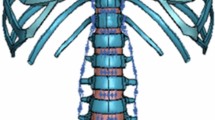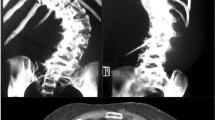Abstract
Scoliosis is thought to progress during growth because spinal deformity produces asymmetrical spinal loading, generating asymmetrical growth, etc. in a ‘vicious cycle.’ The aim of this study was to test quantitatively whether calculated loading asymmetry of a spine with scoliosis, together with measured bone growth sensitivity to altered compression, can explain the observed rate of scoliosis progression in the coronal plane during adolescent growth. The simulated spinal geometry represented a lumbar scoliosis of different initial magnitudes, averaged and scaled from measurements of 15 patients’ radiographs. Level-specific stresses acting on the vertebrae were estimated for each of 11 external loading directions (‘efforts’) from published values of spinal loading asymmetry. These calculations assumed a physiologically plausible muscle activation strategy. The rate of vertebral growth was obtained from published reports of growth of the spine. The distribution of growth across vertebrae was modulated according to published values of growth sensitivity to stress. Mechanically modulated growth of a spine having an initial 13° Cobb scoliosis at age 11 with the spine subjected to an unweighted combination of eleven loading conditions (different effort direction and magnitude) was predicted to progress during growth. The overall shape of the curve was retained. The averaged final lumbar spinal curve magnitude was 32° Cobb at age 16 years for the lower magnitude of effort (that produced compressive stress averaging 0.48 MPa at the curve apex) and it was 38° Cobb when the higher magnitudes of efforts (that produced compressive stress averaging 0.81 MPa at the apex). An initial curve of 26° progressed to 46° and 56°, respectively. The calculated stresses on growth plates were within the range of those measured by intradiscal pressures in typical daily activities. These analyses predicted that a substantial component of scoliosis progression during growth is biomechanically mediated. The rationale for conservative management of scoliosis during skeletal growth assumes a biomechanical mode of deformity progression (Hueter-Volkmann principle). The present study provides a quantitative basis for this previously qualitative hypothesis. The findings suggest that an important difference between progressive and non-progressive scoliosis might lie in the differing muscle activation strategies adopted by individuals, leading to the possibility of improved prognosis and conservative or less invasive interventions.






Similar content being viewed by others
References
Aldegheri R, Agostini S (1993) A chart of anthropometric values. J Bone Joint Surg Br 75(1):86–88
Andersson GBJ, Chaffin DB, Pope MH (1984) Occupational biomechanics of the lumbar spine. In: Pope MH, Frymoyer JW, Andersson G (eds) Occupational low back pain. Praeger Scientific, New York, p. 45
Cassella MC, Hall JE (1991) Current treatment approaches in the nonoperative and operative management of adolescent idiopathic scoliosis. Phys Ther 71:897–909
CDC Growth Charts: United States. STATAGE.XLS: Stature-for-age charts, 2 to 20 years. http://www.cdc.gov/nchs/about/major/nhanes/growthcharts/datafiles.htm. Accessed 12 Apr 2007
Dickson RA, Deacon P (1987) Annotation: spinal growth. J Bone Joint Surg Br 69:690–692
Hughes RE, Chaffin DB, Lavender SA, Andersson GB (1994) Evaluation of muscle force prediction models of the lumbar trunk using surface electromyography. J Orthop Res 12(5):689–698
Lee TS, Chao T, Tang RB, Hsieh CC, Chen SJ, Ho LT (2005) A longitudinal study of growth patterns in schoolchildren in one Taipei District II: sitting height, arm span, body mass index and skinfold thickness. J Chin Med Assoc 68(1):16–20
Little DG, Song KM, Katz D, Herring JA (2000) Relationship of peak height velocity to other maturity indicators in idiopathic scoliosis in girls. J Bone Joint Surg Am 82(5):685–693
Mannion AF, Meier M, Grob D, Muntener M (1998) Paraspinal muscle fibre type alterations associated with scoliosis: an old problem revisited with new evidence. Eur Spine J 7(4):289–293
McNally DS, Adams MA (1992) Internal intervertebral disc mechanics as revealed by stress profilometry. Spine 17(1):66–73
Mente PL, Aronsson DD, Stokes IAF, Iatridis JC (1999) Mechanical modulation of growth for the correction of vertebral wedge deformities. J Orthop Res17:518–524
Nachemson A (1966) The load on lumbar disks in different positions of the body. Clin Orthop Relat Res 45:107–122
Nachemson AL, Peterson LE (1995) Effectiveness of treatment with a brace in girls who have adolescent idiopathic scoliosis. A prospective, controlled study based on data from the Brace Study of the Scoliosis Research Society. J Bone Joint Surg Am 77(6):815–822
Nicolopoulos KS, Burwell RG, Webb JK (1985) Stature and its components in healthy children, sexual dimorphism and age related changes. J Anat 141:105–114
Odermatt D, Mathieu PA, Beausejour M, Labelle H, Aubin CE (2003) Electromyography of scoliotic patients treated with a brace. J Orthop Res 21(5):931–936
Panjabi MM, Takata K, Goel V, Federico D, Oxland T, Duranceau J, Krag M (1991) Thoracic human vertebrae. Quantitative three-dimensional anatomy. Spine 16(8):888–901
Pathmanathan G, Prakash S (1994) Growth of sitting height, subischial leg length and weight in well-off northwestern Indian children. Ann Hum Biol 21(4):325–334
Perié D, Sales de Gauzy J, Curnier D, Hobatho MC (2001) Intervertebral disc modeling using a MRI method: migration of the nucleus zone within scoliotic intervertebral discs. Magn Reson Imaging 19(9):1245–1248
Roaf R (1960) Vertebral growth and its mechanical control. J Bone Joint Surg Br 42:40–59
Stokes IAF, Spence H, Aronsson DD, Kilmer N (1996) Mechanical modulation of vertebral body growth: implications for scoliosis progression. Spine 21(10):1162–1167
Stokes IAF, Gardner-Morse M (2004) Muscle activation strategies and symmetry of spinal loading in the lumbar spine with scoliosis. Spine 29(19):2103–2107
Stokes IAF, Aronsson DD (2001) Disc and vertebral wedging in patients with progressive scoliosis. J Spinal Dis 14:317–322
Stokes IA, Aronsson DD, Dimock AN, Cortright V, Beck S (2006) Endochondral growth in growth plates of three species at two anatomical locations modulated by mechanical compression and tension. J Orthop Res 24(6):1327–1334
Stokes IAF, Gardner-Morse M (1999) Quantitative anatomy of the lumbar musculature. J Biomech 32:311–316
Stokes IA, Gwadera J, Dimock A, Farnum CE, Aronsson DD (2005) Modulation of vertebral and tibial growth by compression loading: diurnal versus full-time loading. J Orthop Res 23:188–195
Stokes IA, Gardner-Morse M (2001) Lumbar spinal muscle activation synergies predicted by multi-criteria cost function. J Biomech 34:733–740
Stokes IAF, Windisch L (2006) Vertebral height growth predominates over intervertebral disc height growth in the adolescent spine. Spine 31(14):1600–1604
Tanner JM, Whitehouse RH, Marubini E, Resele LF (1976) The adolescent growth spurt of boys and girls of the Harpenden growth study. Ann Hum Biol 3(2):109–126
Urban MR, Fairbank JCT, Etherington PJ, Loh L, Winlove CP, Urban JPG (2001) Electrochemical measurement of transport into scoliotic intervertebral discs in vivo using nitrous oxide as a tracer. Spine 26(8):984–990
Villemure I, Aubin CE, Dansereau J, Labelle H (2004) Biomechanical simulations of the spine deformation process in adolescent idiopathic scoliosis from different pathogenesis hypotheses. Eur Spine J 13(1):83–90
Wilke HJ, Neef P, Caimi M, et al (1999) New in vivo measurements of pressures in the intervertebral disc in daily life. Spine 24(8):755–762
Wynarsky GT, Schultz AB (1991) Optimization of skeletal configuration: studies of scoliosis correction biomechanics. J Biomech 24(8):721–732
Acknowledgments
Supported by NIH R01 AR 44119 and NIH R01 AR 46543.
Author information
Authors and Affiliations
Corresponding author
Appendix 1
Appendix 1
In Eq. 2:
(See Fig. 3)
Substituting in Eq. 2:
Evaluating this definite integral:
Rights and permissions
About this article
Cite this article
Stokes, I.A.F. Analysis and simulation of progressive adolescent scoliosis by biomechanical growth modulation. Eur Spine J 16, 1621–1628 (2007). https://doi.org/10.1007/s00586-007-0442-7
Received:
Revised:
Accepted:
Published:
Issue Date:
DOI: https://doi.org/10.1007/s00586-007-0442-7




